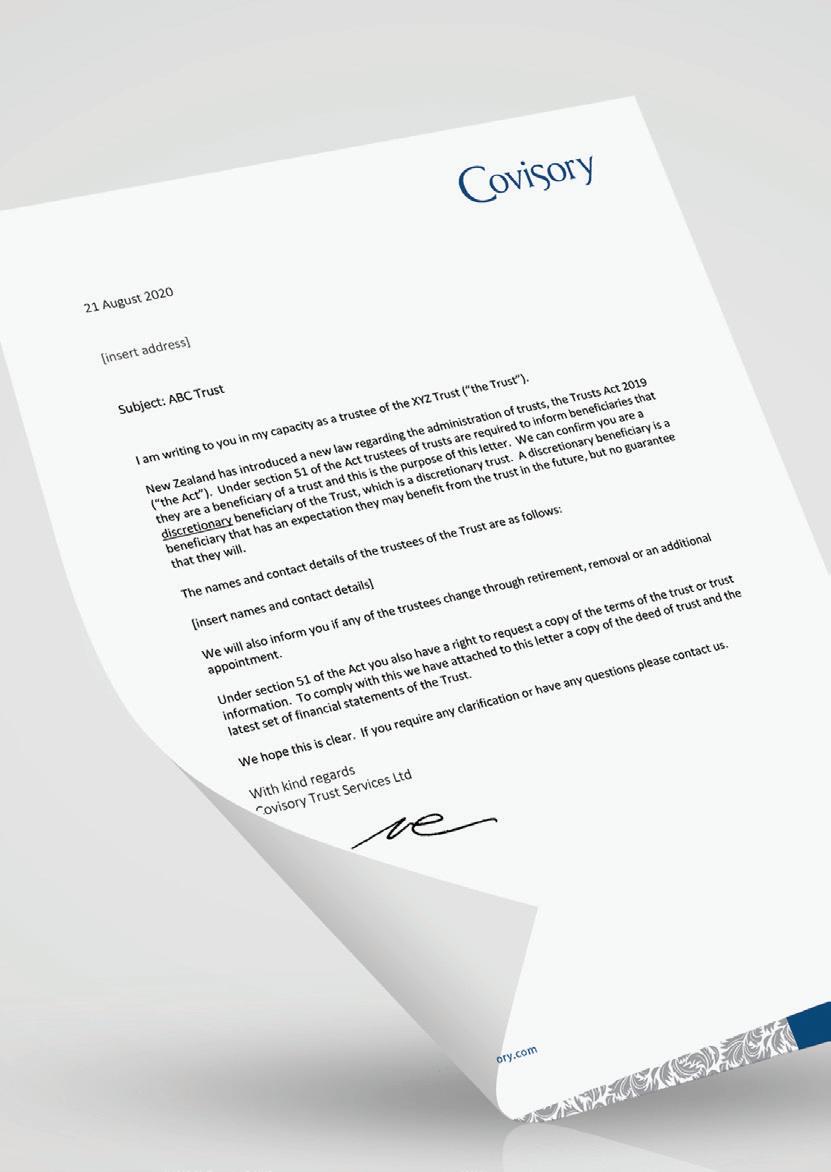
4 minute read
Disclosure to Beneficiaries
The new trust laws in New Zealand becomes law in just under six months. The point the majority of clients are focusing on is disclosure of information to beneficiaries and what this might mean for the administration of the trust.
Clearly a number of trusts include beneficiaries where it was never intended those beneficiaries would benefit. Trustees are now left with working out whether information should be disclosed to those beneficiaries or if there are other option.
Advertisement
There seems to be four main options:
If there is a power to remove beneficiaries, then this can be exercised to remove those beneficiaries who will never benefit. For example, spouses of beneficiaries, nieces and nephews etc. If there is no power to remove then the power of variation could be used to amend the deed of trust to insert one.
If there is no power to remove beneficiaries and there is either no power of variation or the power of variation cannot be used to amend the deed, then the trust can be resettled into a new trust which has a narrower class of beneficiaries. However, the practical issues such as tax impact need to be considered with any resettlement. The trust assets can be distributed out to the settlors and then settled onto a new trust.
If none of the above options are an option, then the trustees could potentially rely on the provisions of section 53 of the Trusts Act 2019.
Whatever option is ultimately appropriate will depend on the provisions of the deed of trust and the wider family dynamics. Under the Trusts Act 2019, the presumption is that a trustee must provide a beneficiary with trust information. Section 53 does allow the trustee to consider a number of factors to decide whether the presumption applies. For family trusts there a number of factors that can be taken into account, including the likelihood of a beneficiary receiving a distribution in the future and the general impact of family relationships. It is expected that there will be a lot of litigation in this area and the trustee will need very good reasons of ignoring the presumption of providing trust information to beneficiaries. The new laws are focused towards trustees being transparent in their administration of the trust.
The rules contained in the Trusts Act 2019 are to a great extent a codification of the common law position on disclosure. To understand how Courts will interpret these rules going forward the recent case of Jacomb v Jacomb can provide some guidance. In this trust one of the beneficiaries had a troubled history with addiction and an acrimonious relationship with the trustees. The beneficiary was both a discretionary and final beneficiary. The High Court weighed up the reasons for and against disclosure and decided information did not need to be disclosed to the beneficiary as there was concern disclosure would lead to a further breakdown in the relationship between the trustees and the beneficiary and that the beneficiary could also misuse the information for dishonest purposes. This case is on the extreme side as the beneficiary clearly had issues.
If you would like to discuss this further or any trust issue you have please call either Marcus or Nigel, we are always happy to hear from you.
Section 53? Do we Disclose?
The take away for trustees is that if the provisions of section 53 are to be relied on in the future then there must be careful consideration of all factors in whether to deny a beneficiary trust information. The Courts will look closely at this and trustees will need to be very clear in their reasons of not disclosing.

Interesting Assignments
Trust Restructuring

We have recently been carrying out trust reviews for a number of clients to ensure existing structures are compliant with the new trust laws that come into force at the end of January 2021. One recent engagement saw us acting in an advisory capacity for a client to review the family trust structure and make recommendations as to how the structure should work going forward. This included a detailed review of the deed of trust and associated documents. The primary client concern was ensuring the structure was still valid and addressing some technical issues within the deed of trust. For example, the class of beneficiaries was very wide in that it included individuals who would never benefit from the trust and there were other drafting issues in respect of how distributions worked between primary and secondary beneficiaries. The result was the trust structure was still relevant and we put in place documents to amend the deed of trust and remove beneficiaries.
A corporate trustee was also put in place to more easily facilitate family succession in the future. The settlors of the trust also needed to put new Wills in place as the current Wills were out of date and not fit for purpose.
Marcus Diprose Covisory Director







